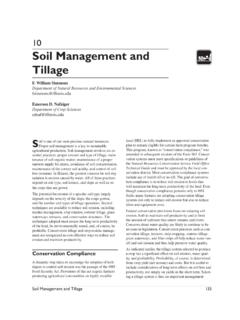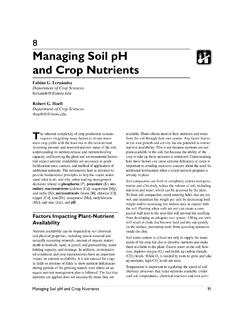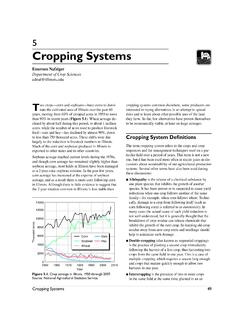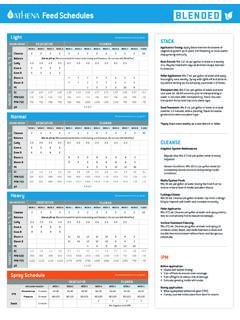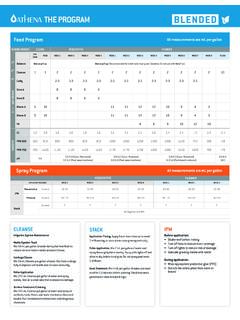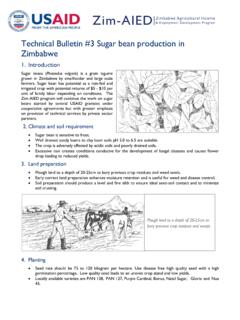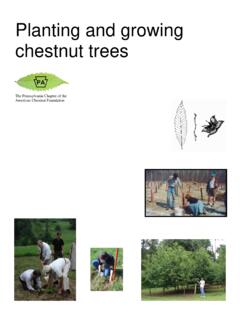Transcription of 6 Hay and Pasture - Extension & Outreach
1 Hay and Pasture Management 656 Hay and Pasture Jim MorrisonRockford Extension BarnhartIowa State UniversityKeith JohnsonPurdue UniversityIllinois hay and Pasture acres can contribute in many ways to the success of a farm enterprise. These crops offer opportunities for producers who decide to manage them properly. The information in this chapter is based on forage research from the University of Illinois and land-grant institutions in two adjacent , productive stands are the result of proven prac-tices: selecting adapted species to your soils and forage need, choosing disease- and insect-resistant varieties that grow and recover quickly after harvest, following good seeding practices, using current soil tests as the basis for lime and fertilizer application, protecting stands from pests and traffic damage, and harvesting at the optimal time. Selecting species and varieties that are winter hardy and persistent also affects stand productivity. For guide-lines on soil fertility management (including soil testing) for hay and Pasture , see Chapter Older Hay and Pasture StandsIs maintaining an older, established stand better than reseeding or establishing a new stand?
2 There are a number of factors to consider when making this pure grass fields, a thick stand over the entire field is essential. Bare or open areas result because of diseases, winter kill, soil fertility, or other problems; they can quickly become infested with weeds, which can lead to further weakening of the stand. As a guide, if a 3-year-old bunch-type grass (such as orchardgrass or timothy) or sod-forming grass (such as smooth bromegrass or Ken-tucky bluegrass) has 50% or less ground cover, the stand should be stands that are relatively consistent in covering the soil may need only fertilizer and closer attention to other management practices, fields with large areas of weeds should be considered priorities for pure legume fields, a good uniform stand is also important. There are two common methods for making alfalfa stand evaluations:l Stem count. Research has shown that the number of stems per square foot is a good indicator of potential yield. Stem counts can be taken when the plants are 4 to 6 inches tall.
3 Simply count any stem the mower would cut. If there are fewer than 39 robust stems per square foot, consider tearing up the Plant count. When evaluating a stand in the early spring, you will have to base your decision on the number of plants (crowns) per square foot since stems may not be tall enough to count. Use the following as a when counts are madeSuggested plants per sq ftFall of the seeding year>20 Spring, 1st full production year>12 Spring, 2nd production year>8 Spring, 3rd production year>5 Another guide for plant count in the spring is that 2-year-old stands with 6 or fewer plants per square foot or 3-year-old stands with 3 or fewer plants per square foot will not produce is the best time to evaluate stands. Include a health assessment of the alfalfa crown and root by digging up a 66 Illinois Agronomy HandbookFigure Spinner-type seeder for frost seeding mounted on an all-terrain of plants from different areas in the field to prop-erly determine crown and root vigor.
4 Roots that exhibit disease or severe discoloration more than a couple of inches below the crown may not survive another season. If you are in doubt, take plants to your local Extension office for further Hay and Pasture : Cool-Season Grasses and LegumesSeeding date in Illinois, either spring or late-summer, de-pends to a great extent on the field s location (Figure ).Spring seedings tend to be more successful in the north-ern half of Illinois than in the southern half. Seeding can occur as soon as a seedbed can be prepared, usually late March to early April. Typically as seeding is delayed past mid-May, soil moisture becomes more limited, weed pres-sure increases, and soil temperature becomes higher. Lack of consistent success with spring seeding in the southern third of Illinois indicates that late-summer seedings may be more seedings for Illinois legumes should be completed 6 to 8 weeks prior to the first killing frost to ensure that plants become well established before winter: August 10 to 15 in the northern quarter, August 30 to September 4 in the central half, and September 5 to 10 in the southern quarter.
5 Top growth of 4 to 6 inches is needed before dormancy. Cool-season grasses can be seeded 1 to 2 weeks later. A firm seedbed enabling seed -to-soil con-tact is critical for late-summer seeding, and adequate soil moisture must be present. Use the same seeding rate as in the spring, and do not include a companion or nurse seeding, or overseeding, is one method of Pasture renovation. A spinner-type seeder (Figure ) is used to surface-broadcast seed into existing vegetation in late winter or very early spring while the soil is still frozen. Success of this method depends on soil freeze thaw cycles, late snowfall, spring rain, and the management of existing vegetation before and after seeding. Frost seeding is more successful in a bunch-type grass than in a sod-forming grass. Due to lack of uniform germination and emergence, frost seeding is more suited to pastures than hay fields. Red clover and white clover are better adapted to frost seed -ing than other legumes.
6 Lespedeza (annual) may also be considered for frost seeding in southern Illinois (see Table ). Ryegrass (annual or Italian type) and orchardgrass are two cool-season grasses that have good seedling vigor and are adapted to frost seeding. Frost seeding will not be suc-cessful every year and is less successful on sandy Suggested seeding dates for Illinois seedingsmore successful (September 5)Spring seedings generally preferred(late March early April)orLate-summer seedings(August 10)Spring seedings(late March early April)orLate-summer seedings(August 10)Northern and central ILRed clover4 6 Northern and central ILWhite clover2 3 White cloverRed clover1 23 4 Southern ILRed clover4 6 Lespedeza (annual)20 25 Southern ILWhite clover2 3 White cloverRed clover1 23 4 Moderately well to well-drained soilsPoorly drained soilsFrost seeding of legumeThe table reflects recommendations from the University of Illinois, Pur-due University, and Iowa State University. Characteristics, strengths, and weaknesses of legumes and grasses are described beginning on page 75.
7 Species grouped between lines are to be planted as a Forage seeding-rate recommendations for frost seeding (in pounds of pure live seed per acre).Spring seedings are generally preferred (late Mar early Apr) or Late-summer seedings (Aug 10 15)Spring seedings (late Mar early Apr) orLate-summer seedings (Aug 30 Sept 4)Late-summer seedings are more successful (Sept 5 10)Hay and Pasture Management 67 Pure Live SeedIn Table , seeding rates are listed in pounds of pure live seed per acre. Pure live seed (PLS) is an indication of seed quality, but this information is rarely shown on seed PLS is calculated by multiplying the purity of the bulk seed lot by the germination rate and dividing by 100. For example: If a bag of a species of seed is 90% pure and has a germination rate of 80%, the PLS would be x 100, or 72% determine how much seed is needed per acre, the PLS recommendation shown in Table would be divided by the PLS percentage and multiplied by 100.
8 For example: If the seeding recommendation in the table is 12 pounds per acre PLS and the PLS is 72%, as in the previous paragraph, the amount of seed to purchase would be 12 72 x 100, or pounds per acre. In other words, you would have to plant pounds of material from the seed bag of that spe-cies in order to plant 12 pounds of PLS per Forage seeding-rate recommendations for hay and Pasture (in pounds of pure live seed per acre).The table reflects recommendations from the University of Illinois, Purdue University, and Iowa State University. Characteristics, strengths, and weak-nesses of legumes and grasses are described beginning on page 75. Species grouped in the same box are to be planted as a Red clover can be added at 4 lb/acre, but the alfalfa rate needs to be reduced by half; alternately, 6 to 8 lb/acre of red clover can be substituted for has questionable persistence to be used in horse canarygrass is an invasive and central ILAlfalfa12 15 AlfalfaaSmooth bromegrass8 106 8 AlfalfaaOrchardgrass8 104 6 AlfalfaaTall fescue8 108 10 Alfalfaa Timothyb8 102 4 AlfalfaaPerennial ryegrass8 104 8 Red cloverWhite cloverOrchardgrass6 8 14 6 Red cloverWhite cloverTall fescue6 8 18 10 White cloverOrchardgrass 16 8 White cloverSmooth bromegrass 18 10 Birdsfoot trefoilTimothyb5 72 4 Birdsfoot trefoilOrchardgrass5 74 6 White cloverPerennial ryegrass 14 8 Birdsfoot trefoilPerennial ryegrass5 74 8 Southern ILAlfalfa12 15 AlfalfaaOrchardgrass8 104 6 White cloverOrchardgrass 16 8 White cloverTall fescue 18 10 AlfalfaaTall fescue8 108 10 AlfalfaaPerennial ryegrass8 104 8 Red cloverWhite cloverOrchardgrass6 8 14 6 Red cloverWhite cloverTall fescue6 8 18 10 Lespedeza (annual)Orchardgrass154 6 Lespedeza (annual)
9 Tall fescue158 10 White cloverPerennial ryegrass 14 8 Lespedeza (annual)White cloverOrchardgrass15 14 6 Moderately well to well-drained soilsNorthern and central ILBirdsfoot trefoilTimothyb5 72 4 Birdsfoot trefoilSmooth bromegrass5 76 8 Alsike clovercWhite clover Timothyb2 3 2 4 Alsike clovercWhite clover Reed canarygrassd2 3 6 8 Alsike cloverc White clover Tall fescue2 3 8 10 Alsike clovercTimothyb3 42 4 Alsike clovercReed canarygrassd3 46 8 White cloverPerennial ryegrass 14 8 Birdsfoot trefoilPerennial ryegrass5 74 8 Southern ILWhite cloverTall fescue 18 10 Alsike clovercRedtop3 44 6 Alsike clovercWhite cloverTall fescue2 3 8 10 Alsike clovercWhite cloverReed canarygrassd2 3 6 8 Alsike clovercReed canarygrassd3 46 8 Birdsfoot trefoilTimothyb5 62 4 White cloverPerennial ryegrass 14 8 Birdsfoot trefoilPerennial ryegrass5 74 8 Poorly drained soilsNorthern and central ILAlfalfa12 15 AlfalfaSmooth bromegrass8 106 8 AlfalfaTall fescue8 106 8 Reed canarygrassd8 10 Southern ILAlfalfa12 15 AlfalfaTall fescue8 106 8 Reed
10 Canarygrassd8 10 Droughty soils68 Illinois Agronomy HandbookTable Forage seeding-rate recommendations for horse pastures (in pounds of pure live seed per acre).Northern and central ILKentucky bluegrass15 AlfalfaaSmooth bromegrass8 106 8 AlfalfaaOrchardgrass8 104 6 AlfalfaaTall fescueb8 108 10 Northern and central ILKentucky bluegrass15 Red cloverTimothyc6 82 4 Red cloverWhite cloverTimothyc4 6 2 4 Birdsfoot trefoilTimothyc6 72 4 White cloverTall fescueb 18 10 Southern ILKentucky bluegrass15 AlfalfaaOrchardgrass8 104 6 AlfalfaaTall fescueb8 108 10 Southern ILKentucky bluegrass15 White cloverKentucky bluegrass 14 5 White cloverOrchardgrass 14 6 Red cloverOrchardgrass6 84 6 White cloverTall fescueb 18 10 Red cloverTall fescueb6 88 10 Moderately well to well-drained soilsPoorly drained soilsThe table reflects recommendations from the University of Illinois, Purdue University, and Iowa State University. Characteristics, strengths, and weaknesses of legumes and grasses are described beginning on page 75.
